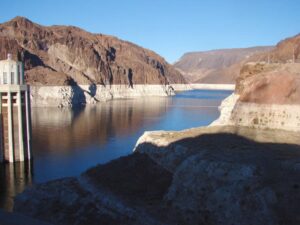San Diego Coastkeeper is made up of water-loving people working hard to protect and restore clean water on behalf of the communities and wildlife that depend on it. We surf, we swim, we SUP, we fish, and then we trade our wetsuits for real suits and meet with stakeholders and decision-makers, advocating for the environment and making sure water has a voice in the rooms where decisions are made. But more and more, as we are talking about water, we find ourselves talking in terms of energy as well. As it turns out, water and energy use are deeply tied in our state, where moving tremendous amounts of water far distances, up and over mountain ranges, has become the norm. How much energy are we using, and how are we impacting our climate by maintaining this relationship with water? As many regions turn to energy-intensive desalination, this conversation becomes more pressing still. Read on as Staff Attorney Josh Brooks takes a deep dive into just how intimately water and energy are linked.
Water and energy resources are fundamentally and inextricably connected. According to the California Energy Commission, the “transportation and treatment of water, treatment and disposal of wastewater, and the energy used to heat and consume water account for nearly 20 percent of the total electricity and 30 percent of non-power plant related natural gas consumed in California.” That’s equivalent to 48 terawatt-hours (TWh) per year, or roughly the entire electricity usage of Romania or Oregon. Given this significant “water-energy nexus,” it is essential that any comparative economic analysis of water supply sources factor in their climate impacts. Likewise, any discussion of climate change should include consideration of the energy and greenhouse gas (GHG) impacts of water production, transportation, treatment, and disposal.


Under the California Environmental Quality Act (CEQA), state and local agencies are required to identify the significant environmental impacts of their actions and avoid or mitigate those impacts, if feasible. Under AB 32, the California Global Warming Solutions Act of 2006, and the AB32 Scoping Plan, state agencies are required to consider and implement strategies to reduce greenhouse gas emissions through 2020. Accordingly, the California State Water Resources Control Board (the agency charged with managing California’s water sector) has acknowledged its legal obligation to meaningfully address climate change with concrete action and has recognized that mitigating climate change necessarily entails “reducing the energy intensity of the water sector, replacing fossil fuels with renewable energy, improving efficiency, and reducing water consumption.” It has also acknowledged that “the potable and non-potable use of recycled water, the use of stormwater, and the use of natural or green infrastructure for storage, movement and treatment, have the potential to reduce greenhouse gas emissions if replacing an existing or future, higher carbon water supplies.” Unfortunately, though, the San Diego Regional Water Quality Control Board, our local subentity of the State Board, has been less forward-thinking on the water-energy nexus issue, and has refused to utilize a loading order that would prioritize water supply sources with lower greenhouse gas profiles, such as conservation, potable reuse, and stormwater capture, over more carbon-intensive sources like imported water and desalination. Nor has it ever assessed the variable energy intensities of different water supply sources and their disparate climate impacts in order to more realistically quantify and compare their true costs and benefits. It’s about time they do so, because the mercury isn’t going to stop rising anytime soon.
As we head into an uncertain future of longer, more severe droughts, increased temperatures and wildly unpredictable weather patterns, water security is going to become more important than ever. When our methods for obtaining, transporting, and treating water are releasing yet more carbon into our overloaded atmosphere and exacerbating the very problems we are aiming to work around, we may find ourselves in a vicious cycle. Now more than ever it’s time to rethink our relationship with water, and prioritize less environmentally harmful water supply sources, such as conservation, water use efficiency, stormwater capture, and potable reuse.















